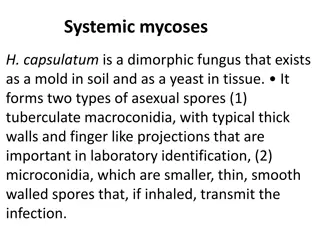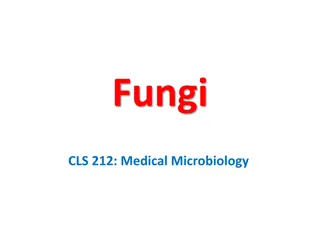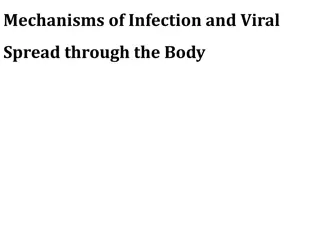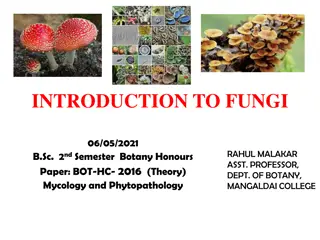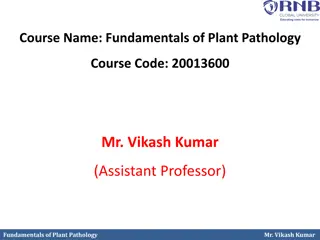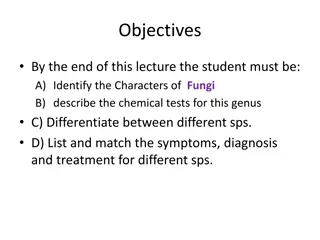Cryptococcus: Mycology and Virulence Insights
Cryptococcus is a genus of encapsulated yeasts with diverse species, primarily C. neoformans and C. gattii causing human cryptococcosis. Understanding their structure, habitat, serotypes, and virulence factors is crucial for diagnosis and management. Key features include polysaccharide capsule formation, various serotypes linked to different patient groups and environments, and virulence factors such as phospholipase B and melanin pigment production.
Download Presentation

Please find below an Image/Link to download the presentation.
The content on the website is provided AS IS for your information and personal use only. It may not be sold, licensed, or shared on other websites without obtaining consent from the author.If you encounter any issues during the download, it is possible that the publisher has removed the file from their server.
You are allowed to download the files provided on this website for personal or commercial use, subject to the condition that they are used lawfully. All files are the property of their respective owners.
The content on the website is provided AS IS for your information and personal use only. It may not be sold, licensed, or shared on other websites without obtaining consent from the author.
E N D
Presentation Transcript
Cryptococcus: Mycology and Virulence Professor Malcolm D. Richardson Mycology Reference Centre, Manchester Manchester University NHS Foundation Trust
Intended learning outcomes To be aware of the common species and habitats of Cryptococcus To understand the structure of Cryptococcus yeasts To be aware of the different serotypes of Cryptococcus spp. To be aware of the virulence factors of Cryptococcus spp.
Cryptococcus Ubiquitous encapsulated yeasts belonging to the division Basidiomycota. Over 70 species of Cryptococcus are known, however, Cryptococcus neoformans and C. gattii are the two main species implicated in nearly all cases of human cryptococcosis. C. neoformans has 2 distinct varieties: C. neoformans var. neoformans C. neoformans var. grubii Other species of less clinical significance includes: C. laurentii, C. adeliensis, C. albidus, etc.
Structure Yeast: round or oval 4-6mm in diameter Surrounded by polysaccharide capsules 20-30mm thick Titan cells ~90-100 mm Melanised Negatively stains with India Ink and nigrosin Stains with PAS and mucicarmine
Habitat C. neoformans Frequently isolated from soil contaminated with pigeon or other bird droppings and NOT in fresh wet droppings. The precise link between C. neoformans and birds to date remains unclear. Birds do not get infected. C. gattii Isolated from decaying wood in the red gum group of eucalyptus trees, cedar, oak and other native trees. C. gattii has not been isolated from bird droppings.
Serotypes of Cryptococcus spp. GEOGRAPHICAL DISTRIBUTION ENVIRONMENTAL ASSOCIATION AFFECTED PATIENT GROUPS PATHOGEN SEROTYPE HIV patients (98% of all isolates ) Immunocompromised patients Rarely immunocompetent C. neoformans var grubii Birds, particularly pigeon excreta A Worldwide C. gattii B,C Tropics and subtropics Eucalyptus trees Immunocompetent patients C. neoformans var neoformans Birds, particularly pigeon excreta Immunocompromised patients Rarely immunocompetent D European countries C. neoformans var grubii/var neoformans hybrid Rare clinical isolate Immunocompromised AD Not known Not known JN Day :Practical Neurology, 2004, 4, 274 285
Virulence factors Major virulence Other virulence Polysaccharide capsule formation Secreted phospholipase B Melanin pigment production Urease production Ability to grow well at 370C Enzymes associated with protection against oxidative stresses Phenotypic switching
Virulence factors Polysaccharide capsule formation Comprised of glucuronoxylomannan (GXM) and galactoxylomannan (GalXM) Key roles Anti-phagocytic Antibody unresponsiveness Inhibition of leucocyte migration Deregulation of cytokine secretion Interference with antigen presentation L-selectin & tumor necrosis factor loss
Virulence factors Melanin pigment production Catalyzed by the enzyme Phenol oxidase Key Roles Antioxidant Cell wall support and integrity Interference with T-cell response Reduction of susceptibility to antifungal agents Abrogation of antibody mediated phagocytosis Protection from extreme temperature
Virulence factors Phenotypic switching Occurs during chronic infection Common in serotype A and D strains of C. neoformans Associated with differential gene expression and capsule changes in virulence Titan cells Titan cell formation Normal sized cell Titan cell
Summary Cryptococcus are ubiquitous encapsulated yeasts. C. neoformans and C. gatti are the two main species implicated in clinical disease. Cryptococcus spp. have a number of virulence factors. C. neoformans var. grubii (serotype A) is the most common cause of disseminated disease in HIV/AIDs patients.




